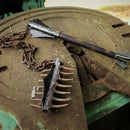Introduction: Air Powered Spud CANNON
Ah yes, the mighty potato cannon. Long the pinnacle of ultimate DIYer status (until the DUCT TAPE TIE came along that is), this has been done and redone about a million and and eight tenths times. There are even whole websites and forums (http://www.spudfiles.com/) devoted to sending spuds into the stratosphere.
Well, almost. More like lower troposphere......
Why another one?
Because. I. Want. To.
I've actually wanted to build a solenoid valve air gun for some time now. A couple years ago I built a PVC air rifle that used a ball valve, and that worked pretty pretty good; but ball valves are, well, ball valves. I did manage to rig it up with some levers and a whole ton of rubber bands which opened the valve very fast, fast enough to get a powerful shot. But it made me want to try other methods.
Like a sprinkler valve. (Yep, the ones powering your lawn sprinkler system) They are electrically operated, using electromagnets to open and close the valve. Add a battery and a switch and BOOM. Super simple trigger mechanism. No more messing around with rubber bands or throwing off your aim by trying to turn a sticky valve.
What better way to try it out than with an air powered spud gun?
WARNING:PVC not exactly designed to hold high air pressure. If you are not careful when constructing this bad boy and make sure all your joints are secure you could have serious consequences. You want to construct a cannon, not a bomb :)
This thing is also rather powerful, and most definitely has the capacity to kill you if you ain't smart. It is very easy to underestimate the power of something you threw together in your garage. That could be a fatal mistake. No joke, people have been killed by misusing spud guns. Don't be stupid.
I'm not responsible for anything you do with the information I'm about to present to you. Attempt at your own risk.
Vote for me in the PVC contest !!!
Step 1: Construction Video
Step 2: Parts and Materials
The parts you are going to need:
- 2" PVC pipe (two foot length) (all PVC parts are schedule 40)
- A short length of 3/4" PVC pipe
- 2" end cap
- 2" straight coupling
- A fitting that goes from 2" to 3/4" threaded fitting. I couldn't find a fitting that went down to 3/4" directly, and had to use several fittings.
- x3 (or 4?) 3/4" male threaded couplings.
- 3/4" Sprinkler Valve
- Switch. You could use just about any kind of switch, I went with a simple rocker switch.
- Bike tire valve (I cut mine off of an old inner tube)
- PVC cement and primer
- Thread sealing tape
I think that's about everything.
Sorry if my parts list isn't very clear, at the store I'm really not thinking of individual parts, I'm more just throwing the stuff that fits together in a bag :) Really though, you can't get any simpler than this cannon design. I'm sure you can figure it out from the pics.
I also included a diagram of the workings of the sprinkler valve, for those who want to understand how they work.
Step 3: Design and Parts Layout
My design for this cannon was basically the simplest one I could come up with. Literally tank + valve + barrel. Nothing fancy here.
The main thing that might vary on your cannon is the barrel and how you attach it. I designed this gun so I could use interchangeable barrels, which is a very cool feature in my opinion.
Here I am just laying all the parts out and dry fitting them together. You logically want to make sure it all fits before permanently gluing it up.........
Step 4: Cut PVC to Size
With your parts dry fitted together, you can see where the PVC needs to be cut down. My design, being so simple only requires two cuts. I cut the 2" pipe down to 20" (air tank), and cut about a 1" long piece of the 3/4" pipe to connect two of the male coupling together.
Step 5: Install Tire Valve
Being the redneck fellow that I am, I opted for the cheap method and used a valve I cut out of an old bike inner tube.
A better idea would be to buy a metal valve at the hardware store, which can be threaded right into the PVC of the air tank.
Not that the redneck option is more likely to fail, actually they have held up wonderfully in my experience (no worries there). But a metal valve would be nice.
First I drill a hole in the top of the end cap, just large enough for the end of the valve to slide through. Then I glue the two permanently together using five minute epoxy. I rigged the parts up in my vice so I wouldn't have to hold them together while the epoxy cured.
Step 6: (Coffee Break)
Most important part of the whole build.
Step 7: Clean PVC for Glueing
If the air tank wasn't going to have to hold together at 80 psi, cleaning the PVC before gluing wouldn't matter.
But it is. And if you are anything like me, you generally don't appreciate parts of your gun flying off at random times.
It gets annoying.
Yeah.
So to be extra sure that everything will hold together, it is best to clean the PVC well before slapping cement and primer on it. I used some denatured alcohol to get the surfaces as clean as possible.
Step 8: Prime and Cement Parts
The second most important part of the whole build. (Get your priorities right. Coffee first. Always.)
First of all, do this in a well ventilated area or outdoors. This junk smells like nothing else, and according to the warnings on the can, is as bad for you as it smells. Don't breathe it.
Its fairly easy to use. Apply the primer, let it dry for a few minutes, and apply the cement (don't go crazy with it, but don't put too little either). Push the pieces fully onto each other, one quarter turn; and boom. Instant bond.
I'm always extra careful in this step. Remember that the parts must hold considerable pressure. If one of your joints doesn't get a good bond, you could be in serious trouble later when pressurizing this thing. Follow the directions on the can, and you should be good.
Step 9: Attaching Valve to Air Tank
The sprinkler valve threads right onto the male adapter coming from the air tank. Because the threads don't make a perfect air seal, be sure to use some thread sealing tape.
My solenoid valve is also a one directional valve, with arrows telling me what side the inflow and outflow needs to be. I believe most solenoids are, so be sure to get that right. Otherwise the valve won't work.
And it would be nice if your valve worked.
Step 10: Handle
At this point, the gun was finished except for the wiring.
But it was missing something. I realized it needed a handle somewhere.
No problemo. A few minutes and a scrap piece of 1x6" (ish) and it was good to go. Yeah, I attached it with duct tape. (Greatest invention of mankind. Besides soft serve ice cream. And coffee. And gunpowder. Computers are awesome too. And the internet. And knives.)
Anyway.
A better method would be to use a couple of those ratcheting pipe clamps, but I didn't have any on hand and didn't feel like waiting till I could get to the store.
Step 11: Wiring Up the Solenoid
First a confession: the pics you have here are of me wiring it wrong. Somehow I managed to miswire the most simple circuit in existence.
No worries, look at the diagram and you can't mess it up.
(^^ I'm lying. You still can.)
Anyway. I rewired it off camera and got it right.
At first I thought a single 9v battery would be sufficient to power the valve. It worked to open the valve at low pressures great, so I just assumed the same would go for as much pressure as i'd put in it.
I was wrong. As soon as I got the air pressure above 40 psi the single 9v would not open the valve. I quickly hooked up an 18v drill battery, and it opened no problem. So as you can see from the pictures, I wired together two 9v's, which of course brings me up to 18v. And that has worked great.
For those wondering why I am just duct taping everything together: I am not doing that just because I am too lazy to figure out a better way. Actually, I am planning on experimenting with other ways of triggering this gun in the future (different switches, remote detonation, motion sensors, etc), so I am not wanting to set the design in stone here. You can do it more permanently.
Step 12: Interchangeable Barrels
I am calling this spud gun a cannon, as that was my main purpose for this gun, but since I made it to take interchangeable barrels, it can really be anything I want!
So far I have made four barrels for the gun; a 3", 2", 1&1/2", and a 3/4" rifle barrel. That leaves me with a large range of options for projectiles.
Step 13: Finished Gun and Testing Video
Now time for test firing!
Pump up the gun to 80 psi. I'm not going to be going higher than 80 psi for this gun, as that is what the valve is rated at. The PVC is safe past 100, but as I don't feel like blowing out my valve i'm calling the limit at 80.
Unfortunately, the gun ended up being not quite as powerful as I'd hoped. It is not as powerful as my combustion powered spud gun, and only fired tubers about 80 yards. Not very impressive. Looking back, I should have used a larger air tank. It is plenty of air for my smaller barrels, but when I go up to the larger diameter barrels (which take more air volume to pressurize sufficiently) the shots are underpowered. Bummer.
Watch the video if you want to see the full test. A description is about worthless.
To wrap up; if I were to build this again, I would make the air tank about twice the size it is now. I would also use a larger diameter solenoid, which would hopefully increase the amount of air released into the barrel at the instant the valve is opened. That should give me the increased power for larger barrels that I am looking for. Oh well, it's a learning experience. The cannon is still plenty of fun.
If you like the Instructable, (and think it worthy) VOTE for me in the PVC contest.
Thanks for reading!
Jake
Website: http://www.jakemakes.net/
Youtube: https://www.youtube.com/channel/UCszMFa_qz5weFBoQ7olwlGw

Participated in the
PVC Contest 2017











